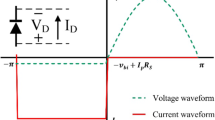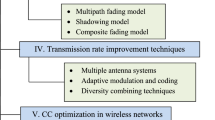Abstract
In this paper, we analyze the performance of Non Orthogonal Multiple Access (NOMA) Energy harvesting relaying system in presence of hardware impairments at both the transmitter and receiver over a Nakagami-m fading channel. The proposed system with destinations are allocated different power levels in which the source node communicates with the destinations via an energy harvesting (EH) relay employing a power-splitting relaying architecture and a direct link to the near destination. Moreover, the amplify-and-forward protocol at the EH relay is investigated to evaluate the performance of system. Additionally, the expressions for outage probability are derived, and these analyses are verified by a Monte Carlo simulation. Furthermore, these results are also compared to an orthogonal multiple access (OMA) system. Finally, the effects of various parameters, such as power allocation levels, position of EH relay node, channel coefficients, and hardware impairment levels on the outage performance and throughput of proposed NOMA-EH system and OMA system are investigated. These results demonstrate the advantage of NOMA-EH system as user fairness since multiple destinations compared to the OMA-EH system.






Similar content being viewed by others
References
Zhu, L., Xiao, Z., Xia, X., & Wu, D. O. (2019). Millimeter-wave communications with non-orthogonal multiple access for B5G/6G. IEEE Access, 7, 116123–116132.
Ding, L., Choi, S., & Elkashlan, M. (2017). Application of non-orthogonal multiple access in LTE and 5G networks. IEEE Communications Magazine, 55, 185–191.
Liaqat, M., Noordin, K. A., Abdul Latef, T., et al. (2020). Power-domain non orthogonal multiple access (PD-NOMA) in cooperative networks: An overview. Wireless Network, 26, 181–203.
Gui, G., Sari, H., & Biglieri, E. (2019). A new definition of fairness for non-orthogonal multiple access. IEEE Communications Letters, 23(7), 1267–1271.
Al-Hussaibi, W. A., & Ali, F. H. (2019). Efficient user clustering, receive antenna selection, and power allocation algorithms for massive MIMO-NOMA systems. IEEE Access, 7, 31865–31882.
Le, T. A., & Kong, H. Y. (2020). Energy harvesting relay-antenna selection in cooperative MIMO-NOMA network over Rayleigh fading. Wireless Network, 26, 2075–2087.
Amin, A. A., Narottama, B., & Shin, S. Y. (2019). Capacity enhancement of cooperative NOMA over Rician fading channels with orbital angular momentum. arXiv:1906.09026.
Im, G., & Lee, J. H. (2019). Outage probability for cooperative NOMA systems with imperfect SIC in cognitive radio networks. IEEE Communications Letters, 23(4), 692–695.
Paradiso, J., & Starner, T. (2005). Energy scavenging for mobile and wireless electronics. IEEE Pervasive Computing, 4(1), 18–27.
Varshney, L. (2008). Transporting information and energy simultaneously. In IEEE international symposium on information theory, 2008. ISIT 2008 (pp. 1612–1616).
Nasir, A. A., & Durrani, S. (2013). Relaying protocols for wireless energy harvesting and information processing. IEEE Transactions on Wireless Communications, 12, 3622–3636.
Nasir, A. A., Tuan, H. D., Duong, T. Q., & Debbah, M. (2019). NOMA throughput and energy efficiency in energy harvesting enabled networks. IEEE Transactions on Communications, 67(9), 6499–6511. https://doi.org/10.1109/TCOMM.2019.2919558.
Le, T. A., & Kong, H. Y. (2019). Secrecy analysis of a cooperative NOMA network using an EH untrusted relay. International Journal of Electronics, 106(6), 799–815. https://doi.org/10.1080/00207217.2019.1570554.
Wang, X., et al. (2019). Energy efficiency optimization for NOMA-based cognitive radio with energy harvesting. IEEE Access, 7, 139172–139180.
Schenk, T. (2008). RF imperfections in high-rate wireless systems: Impact and digital compensation. Berlin: Springer.
Costa, E., & Pupolin, S. (2002). m-QAM-OFDM system performance inthe presence of a nonlinear amplifier and phase noise. IEEE Transactions on Communications, 50(3), 462–472.
Guo, K., Chen, J., Li, G., & Wang, X. (2014). Outage analysis of cooperative cellular network with hardware impairments. In 2014 International Conference on Information Science, Electronics and Electrical Engineering (Vol. 3, pp. 1416–1420). IEEE.
Matthaiou, M., Papadogiannis, A., Bjornson, E., & Debbah, M. (2013). Two-way relaying under the presence of relay transceiver hardware impairments. IEEE Communications Letters, 16(6), 1136–1139.
Li, X., et al. (2019). Security and reliability performance analysis of cooperative multi-relay systems with nonlinear energy harvesters and hardware impairments. IEEE Access, 7, 102644–102661. https://doi.org/10.1109/ACCESS.2019.2930664.
Solanki, S., Singh, V., & Upadhyay, P. K. (2019). RF energy harvesting in hybrid two-way relaying systems with hardware impairments. IEEE Transactions on Vehicular Technology, 68(12), 11792–11805. https://doi.org/10.1109/TVT.2019.2944248.
Li, X., Li, J., Liu, Y., Ding, Z., & Nallanathan, A. (2020). Residual transceiver hardware impairments on cooperative NOMA networks. IEEE Transactions on Wireless Communications, 19(1), 680–695. https://doi.org/10.1109/TWC.2019.2947670.
Tang, X., et al. (2019). On the performance of two-way multiple relay non-orthogonal multiple access-based networks with hardware impairments. IEEE Access, 7, 128896–128909. https://doi.org/10.1109/ACCESS.2019.2939436.
Simon, M. K., & Alouini, M.-S. (2000). Digital communication over fading channels. New York: Wiley.
Gradshteyn, I. S., & Ryzhik, I. M. (2014). Table of intergrals, series, and products (8th ed.). London: Academic Press.
Author information
Authors and Affiliations
Corresponding author
Additional information
Publisher's Note
Springer Nature remains neutral with regard to jurisdictional claims in published maps and institutional affiliations.
Appendices
Appendix 1: Proof of Theorem 1
This appendix derives the outage probability \(OP_1\) at Destination 1 in (22–25) from \(P_1\) and \(P_2\) in Eq. (19).
Let consider \(P_1\): According to Eq. (20), the components \(\left( {\frac{{{\alpha _1}}}{{{\gamma _1}}} - \varepsilon {\alpha _2} - K_1^2} \right)\) and \(\left( {\frac{{{\alpha _2}}}{{{\gamma _2}}} - {\alpha _1} - K_1^2} \right)\) can be negative or positive. Thus, we consider some cases to calculate the OP at \({\mathcal {D}}_1\) as follows:
+ If \(\mathrm{{max}}\left\{ {\frac{{{\alpha _2}}}{{{\gamma _2}}} - {\alpha _1},\frac{{{\alpha _1}}}{{{\gamma _1}}} - \varepsilon {\alpha _2}} \right\} \le K_1^2\), Eq. (20) can be rewritten as
+ If \(\frac{{{\alpha _2}}}{{{\gamma _2}}} - {\alpha _1} \le K_1^2 \le \frac{{{\alpha _1}}}{{{\gamma _1}}} - \varepsilon {\alpha _2}\), Eq. (20) can be rewritten as
+ If \(\frac{{{\alpha _1}}}{{{\gamma _1}}} \le K_1^2 \le \frac{{{\alpha _2}}}{{{\gamma _2}}} - {\alpha _1}\), Eq. (20) can be rewritten as
+ If \(K_1^2 < \min \left\{ {\frac{{{\alpha _2}}}{{{\gamma _2}}} - {\alpha _1},\frac{{{\alpha _1}}}{{{\gamma _1}}} - \varepsilon {\alpha _2}} \right\}\), Eq. (20) can be rewritten as
By applying Eq. (1), \(P_1\) is given by
Let consider \(P_2\): It can be seen that the sign of \(\left( {\frac{{{\alpha _2}{A_2}}}{{{\gamma _2}}} - {A_3}} \right)\) is is the same as the sign of \(\left( {\frac{{{\alpha _2}}}{{{\gamma _2}}} - {\alpha _1} - K_{A{F_1}}^2} \right)\), and the sign of \(\left( {\frac{{{\alpha _1}{A_2}}}{{{\gamma _1}}} - {A_5}} \right)\) is the same as the sign of \(\left( {\frac{{{\alpha _1}}}{{{\gamma _1}}} - \varepsilon {\alpha _2} - K_{A{F_1}}^2} \right)\) due to \({A_2} = \frac{{\theta \mu {P_s}}}{{d_0^\lambda d_3^\lambda \sigma _{{D_1}}^2\left( {1 + K_{SR}^2} \right) }}\) , \({A_3} = \frac{{\theta \mu {P_s}\left( {{\alpha _1} + K_{AF1}^2} \right) }}{{d_0^\lambda d_3^\lambda \sigma _{{D_1}}^2\left( {1 + K_{SR}^2} \right) }}\), and \({A_5} = \frac{{\theta \mu {P_s}\left( {\varepsilon {\alpha _2} + K_{AF1}^2} \right) }}{{d_0^\lambda d_3^\lambda \sigma _{{D_1}}^2\left( {1 + K_{SR}^2} \right) }}\).
+ If \({\mathrm{{max}}}\left\{ {\frac{{{\alpha _2}}}{{{\gamma _2}}} - {\alpha _1},\frac{{{\alpha _1}}}{{{\gamma _1}}} - \varepsilon {\alpha _2}} \right\} \le K_{\mathrm{{A}}{\mathrm{{F}}_1}}^2\), \(P_2\) can be expressed as
+ If \(\frac{{{\alpha _2}}}{{{\gamma _2}}} - {\alpha _1} \le K_{A{F_1}}^2 \le \frac{{{\alpha _1}}}{{{\gamma _1}}}\) , \(P_2\) can be expressed as
+ If \(\frac{{{\alpha _1}}}{{{\gamma _1}}} - \varepsilon {\alpha _2} \le K_{A{F_1}}^2 \le \frac{{{\alpha _2}}}{{{\gamma _2}}} - {\alpha _1}\) , \(P_2\) can be expressed as
+ If \(K_{A{F_1}}^2 < \min \left\{ {\frac{{{\alpha _2}}}{{{\gamma _2}}} - {\alpha _1},\frac{{{\alpha _1}}}{{{\gamma _1}}} - \varepsilon {\alpha _2}} \right\}\) , \(P_2\) can be expressed as
where \(X = {\left| {{h_0}} \right| ^2}\) , \(Y = {\left| {{h_3}} \right| ^2}\) .
By substituting Eqs. (1) and (2) to (A11), Equation in (A11) can be expressed as
Using Eq. [24, Eq.(3.351)], \(I_1\) can be formulated as
Considering \(I_2\) as follows
Applying the Newton binomial as \({\left( {a + b} \right) ^k} = \sum \limits _{i = 0}^k {\left( \begin{array}{l} k\\ i \end{array} \right) } {a^{k - i}}{b^i}\), and using [24, Eq.(3.471.9)] \(I_2\) can be expressed as
where \(K_i[.]\) is the Bessel function. In fact, because of the value of hardware impairment level of \(K_{A{F_1}}^2 > K_1^2\) , due to the combination of result \(P_1\) and \(P_2\) we obtain \(OP_1\) at \({\mathcal {D}}_1\) as in (22–25). This ends the Proof of Theorem 1.
Appendix 2: Proof of Theorem 2
This appendix derives OP in (27) at \({\mathcal {D}}_2\) of the proposed system with the EH relaying node using AF protocol. According to (26) shown that \(\left( {\frac{{{\alpha _2}}}{{{\gamma _2}}} - {\alpha _1} - K_{AF}^2} \right)\) can be negative or positive, thus we consider two cases as follows:
+ If \(\frac{{{\alpha _2}}}{{{\gamma _2}}} - {\alpha _1} \le K_{AF}^2\) , Eq. (26) can be expressed as
+ If \(\frac{{{\alpha _2}}}{{{\gamma _2}}} - {\alpha _1} > K_{AF}^2\), Eq. (26) can be expressed as
where \(Z = {\left| {{h_2}} \right| ^2}\). By substituting (1) and (2) to (B2), Equation in (B2) can be expressed as
\(I_3\) and \(I_4\) components are formulated similar to the calculate \(I_1\) and \(I_2\) in “Appendix 1”. Thus, we obtain OP at \({\mathcal {D}}_2\) as in (27). This ends the Proof of Theorem 2.
Rights and permissions
About this article
Cite this article
Le, T.A., Kong, H.Y. Effects of Hardware Impairment on the Cooperative NOMA EH Relaying Network Over Nakagami-m Fading Channels. Wireless Pers Commun 116, 3577–3597 (2021). https://doi.org/10.1007/s11277-020-07866-2
Accepted:
Published:
Issue Date:
DOI: https://doi.org/10.1007/s11277-020-07866-2




